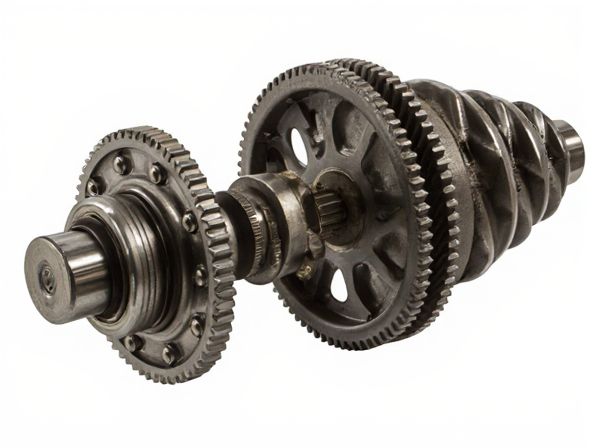
Photo illustration: Ball Differential vs Gear Differential
A Ball Differential offers smoother and more precise adjustments, making it ideal for high-performance RC cars and off-road vehicles requiring fine-tuned traction control. Gear Differentials provide durability and consistent power distribution, suitable for heavier loads and harsher driving conditions where reliability is essential. Understanding the differences helps you choose the right differential type to optimize your vehicle's handling and performance.
Table of Comparison
| Feature | Ball Differential | Gear Differential |
|---|---|---|
| Mechanism | Uses ball bearings and plates for smooth torque transfer | Employs interlocking gears to distribute torque evenly |
| Performance | Provides adjustable slip for better cornering control | Delivers consistent torque distribution to both wheels |
| Maintenance | Requires frequent cleaning and lubrication | Low maintenance due to simple gear assembly |
| Durability | Less durable under high stress conditions | Highly durable, suitable for heavy loads |
| Cost | Generally more expensive due to precision parts | More affordable and widely available |
Introduction to Differentials
Differentials allow wheels to rotate at different speeds, essential for smooth turns and traction. Ball differentials use balls and plates to distribute torque smoothly, offering adjustable slip and reduced binding in RC cars. Gear differentials employ interlocking bevel gears for durable, consistent power transfer in various vehicles.
Overview of Ball Differentials
Ball differentials utilize a set of small steel balls that sit between two plates to provide smooth and adjustable torque transfer, enhancing traction and cornering in radio-controlled vehicles. Unlike gear differentials that mesh gears to distribute power, ball differentials reduce gear lash and offer fine-tuning of preload and slippage, crucial for handling varied track conditions. Their lightweight design and customizable tension settings are preferred in competitive RC racing for precise control and improved performance.
Overview of Gear Differentials
Gear differentials use a series of interlocking gears to distribute torque between wheels, allowing for smooth power transfer and improved traction during turns. They provide consistent performance under various driving conditions and are known for durability and precise torque distribution. Commonly found in both on-road and off-road RC vehicles, gear differentials require less maintenance compared to ball differentials.
Key Differences Between Ball and Gear Differentials
Ball differentials use small steel balls to transfer torque, offering smooth and adjustable slippage ideal for RC cars and lightweight applications. Gear differentials employ meshed gears that provide precise power distribution and durability, suited for heavier loads and high-performance vehicles. The key differences lie in torque handling, maintenance complexity, and how each manages traction under varying driving conditions.
Performance Comparison: Ball vs Gear Differential
Ball differentials excel in smooth power distribution and fine-tuned traction control, making them ideal for high-performance RC cars and off-road vehicles. Gear differentials provide robust durability and consistent torque delivery, suitable for high-stress applications and heavy-load conditions. Performance-wise, ball differentials offer superior cornering agility, while gear differentials deliver better reliability under extreme mechanical stress.
Maintenance and Durability Considerations
Ball differentials require regular cleaning and lubrication to maintain smooth performance, with frequent inspection of ball bearings to prevent wear and ensure optimal function. Gear differentials generally offer higher durability under heavy loads due to their robust metal gears, but they need proper lubrication and periodic checks for gear wear and teeth damage. Choosing between the two depends on the specific application, as ball differentials offer fine-tuned adjustability while gear differentials excel in longevity and low-maintenance reliability.
Applications: Where Each Differential Excels
Ball differentials excel in radio-controlled cars and robotics where smooth, precise control and adjustable slip are crucial for maneuverability on varying terrains. Gear differentials are preferred in full-sized vehicles and heavy machinery due to their durability, high torque capacity, and ability to evenly distribute power to wheels during turns. Each differential type optimizes performance based on application-specific demands, with ball differentials offering finesse in lightweight models and gear differentials providing robustness in larger, high-power systems.
Cost Analysis: Ball vs Gear Differential
Ball differentials often have higher initial costs due to their precision components and ease of tuning, making them a preferred choice for high-performance applications. Gear differentials generally offer lower upfront prices and increased durability under heavy loads but may require more maintenance over time. Evaluating the total cost of ownership involves balancing the premium cost of ball differentials with their performance benefits against the affordability and robustness of gear differentials.
Pros and Cons Summary
Ball differentials offer smoother operation and adjustable slippage, enhancing traction on varied surfaces and improving handling in RC cars and off-road vehicles. Gear differentials provide robust durability and consistent power distribution, making them ideal for high-torque applications but with less customizable slip and potentially harsher response. The choice depends on balancing smooth performance and adjustability from ball differentials against the strength and reliability of gear differentials.
Choosing the Right Differential for Your Needs
Choosing the right differential depends on your vehicle's performance requirements and terrain conditions; a ball differential offers smoother operation and better adjustability for RC cars and lightweight vehicles, enhancing cornering precision. In contrast, gear differentials provide durability and consistent torque distribution suitable for off-road vehicles or heavier loads, ensuring reliability under high-stress conditions. Evaluating factors like maintenance frequency, driving style, and specific application will help determine whether the precision of a ball differential or the robustness of a gear differential best meets your needs.
 caratoz.com
caratoz.com